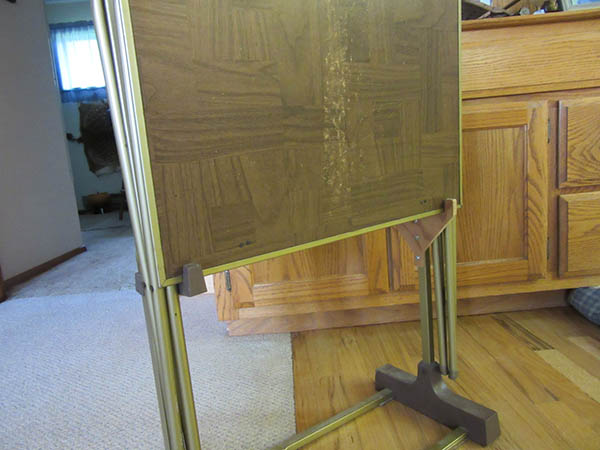In last issue’s eZine, Rob asked whether any other eZine readers had ever fixed problem – any kind of problem – with wood. Here are some of your stories. – Editor

“Here’s one of my repairs using wood instead of the original plastic. One of the cheap plastic arms that holds our TV trays in the stand broke for some unknown reason. I replaced it with a good wooden one. This is the way they should have been built in the first place.” – Rick Corbitt
“Years before I got really serious about woodworking, it was my go-to material for fixing something that was broken as I had slim to no experience with other materials. One fix that I still have is the handle at the top of a trash can that I use to keep dog food in, out in the garage. As is typical with metal trash cans, the handle is spot-welded on instead of riveted as they were in the past. It did not take long for those welds to fail. I took a scrap of 5/4 ash I had from a project of making a sled for my youngest child and shaped into a reasonable facsimile of a handle and screwed it on. A couple of licks of polyurethane and, voila, she’s a-fixed.” – Lee Ohmart
“The hub broke out of one of the plastic wheels on the legs of my radial arm saw. The saw is old, and replacement wheels were not available for purchase. So I cut a disk out of a scrap piece of oak, ground out the interior of the plastic wheel, and pressed the remaining plastic rim over the oak ‘hub.’ A small piece of scrap copper tubing serves as an axle bushing. That wheel is still in service! “ – Douglas Adams
“Your discussion of repairs reminds me of when the upper basket of my old dishwasher was sagging due to corrosion of the wire frame. This was in the 1970s soon after buying my first house, so I was ‘house-poor’ at the time. I had some apitong left over from a project on my old wooden boat. I sawed out some 3/8-inch by 1 and1/2-inch slats and fastened them along the sides of the basket with stainless machine screws, nuts and fender washers. This held up for several years until the pump failed, and I decided a wooden repair would not work this time. (The fact that I had married in the meantime had nothing to do with this decision.)” – Keith McKinnon
“If your only tool is a hammer…all problems look like nails! My woodworking solution to something that should not have been is the gizmo that holds my ancient surveyor’s transit to its brand-new tripod. I use this tool for laying out fields on our vegetable farm, so engineering-level precision is not really crucial.
“The transit’s bottom is too small for the top of the tripod, so I made a reducer to fit into the hole out of a couple of pieces of ¼-inch plywood, one cut in a circle big enough to cover the table of the tripod and one to fit into the access hole. These were glued together and a 1-inch hole drilled through the middle to accommodate the screw that holds the tripod to the transit with a little wiggle room for adjustment. I then epoxied these to the tripod table. Because the screw that holds the tripod and transit together and holds the plumb bob on the bottom had different threads than the transit, I used a hex-headed ½-inch machine screw that fit the transit and fitted it into a chunk of dowel to make a nice big head that I can turn by hand. I then ran a loop of wire through the contraption to hold the plumb bob.
“No, I couldn’t find an appropriate ancient tripod that fit the transit. That would have been really nice. I probably should have taken the whole shebang to a surveyor’s shop for a complete refurbishing but I live in the boonies and the nearest such shop is about four hours away. It works. What else can I say?” – Louise Heite





